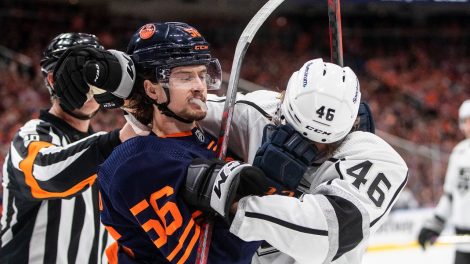Thomas Vanek was a reclamation project when the Detroit Red Wings signed him this summer and with 38 points in 48 games he’s worked out splendidly. But with Detroit out of the playoff race and Vanek bound for unrestricted free agency, it was not surprising to see the 33-year-old winger move at this year’s NHL trade deadline.
What may have caught some people off guard was the modest price. In exchange for Vanek, all the Florida Panthers had to pay was a third-round pick and the rights to AHL defenceman Dylan McIlrath.
That’s basically the same price the Ottawa Senators paid for Viktor Stalberg and his 12 points. It’s arguably less than the Sens paid for Alex Burrows (20 points) or what Edmonton coughed up for David Desharnais (10 points). In a market with so few sellers, why did a potent offensive weapon like Vanek not command more of a return?
Look no further than Red Wings coach Jeff Blashill and what appears to be a healthy appreciation by other NHL teams for the ways a coach can make an individual player look good.
Of the 400-odd NHL players who have played at least 200 minutes at 5-on-5 this season, Vanek is the most sheltered in terms of where his coach deploys him. In recent years, we’ve seen certain coaches become increasingly extreme in their player usage, deploying specific skaters as specialists in the offensive zone or defensive zone.

Vanek has been used as an offensive zone specialist to an amazing degree. Over the entire history of the analytics era, only four NHL forwards have ever had an entire season in which they were on the ice for more even-strength faceoffs in the offensive zone than the neutral and defensive zones combined.
Detroit did it with enforcer Aaron Downey in 2007-08 to keep his goals against down. Vancouver did it with Henrik Sedin in 2011-12, as Alain Vigneault pushed that line hard for offence.
The only other player to be so carefully handled in the analytics era is Mike Ribeiro, who bears the distinction of being the only NHL forward to ever top the 50 per cent offensive zone starts mark in consecutive seasons. Both this year and last year he was used more in the offensive zone than the neutral and defensive zones combined.
Nashville evidently got tired of handling Ribeiro with kid gloves. Despite the fact he put up a very respectable 25 points in 46 games as an offensive centre in a league where a lot of teams lack them and his standing as a pending free agent, he was waived in early February. Nobody claimed him. Now he plays for the Milwaukee Admirals.
Vanek is not Ribeiro, and Blashill’s handling of him has paid off for Detroit in some ways. Vanek is averaging 2.8 points/hour at 5-on-5, which ranks him sixth in the NHL, just back of Sidney Crosby and Evgeni Malkin. He also leads the team with 11 power play points, something he wouldn’t be able to do if Blashill hadn’t found a job for him at even-strength.
Yet the Red Wings were still out-shot when Vanek was on the ice, even though for much of the year he has been propped up by excellent two-way centre Frans Nielsen. Nielsen has of course had much more difficult assignments when not playing with Vanek.
Florida didn’t pick up a true top-six forward on Wednesday, someone comparable to a Radim Vrbata or even an Alex Burrows. Instead, they grabbed a player who is a pure specialist, in much the same way as a faceoff-winning/penalty-killing fourth-line centre is. Vanek can score, but he’s a player who at this stage of his career needs to be carefully handled lest he become more liability than asset.
The Panthers, who finally have their forwards healthy, have the ability to use Vanek properly. They can put together three very good forward lines, and that makes it possible to turn one of those units into an offensive zone specialty line.
Most teams just don’t have that luxury, and many of those that do already have a player they’re carefully sheltering. There’s also the matter of Vanek’s skating, something which would keep him from being a fit in a lot of systems. Considering all this, it makes sense that the market for this player would be soft.
Ken Holland will undoubtedly face criticism over the trade return here, but he doesn’t really deserve it. A third-round pick and some organizational defensive depth is a decent haul for renting out a one-dimensional winger.
[relatedlinks]









